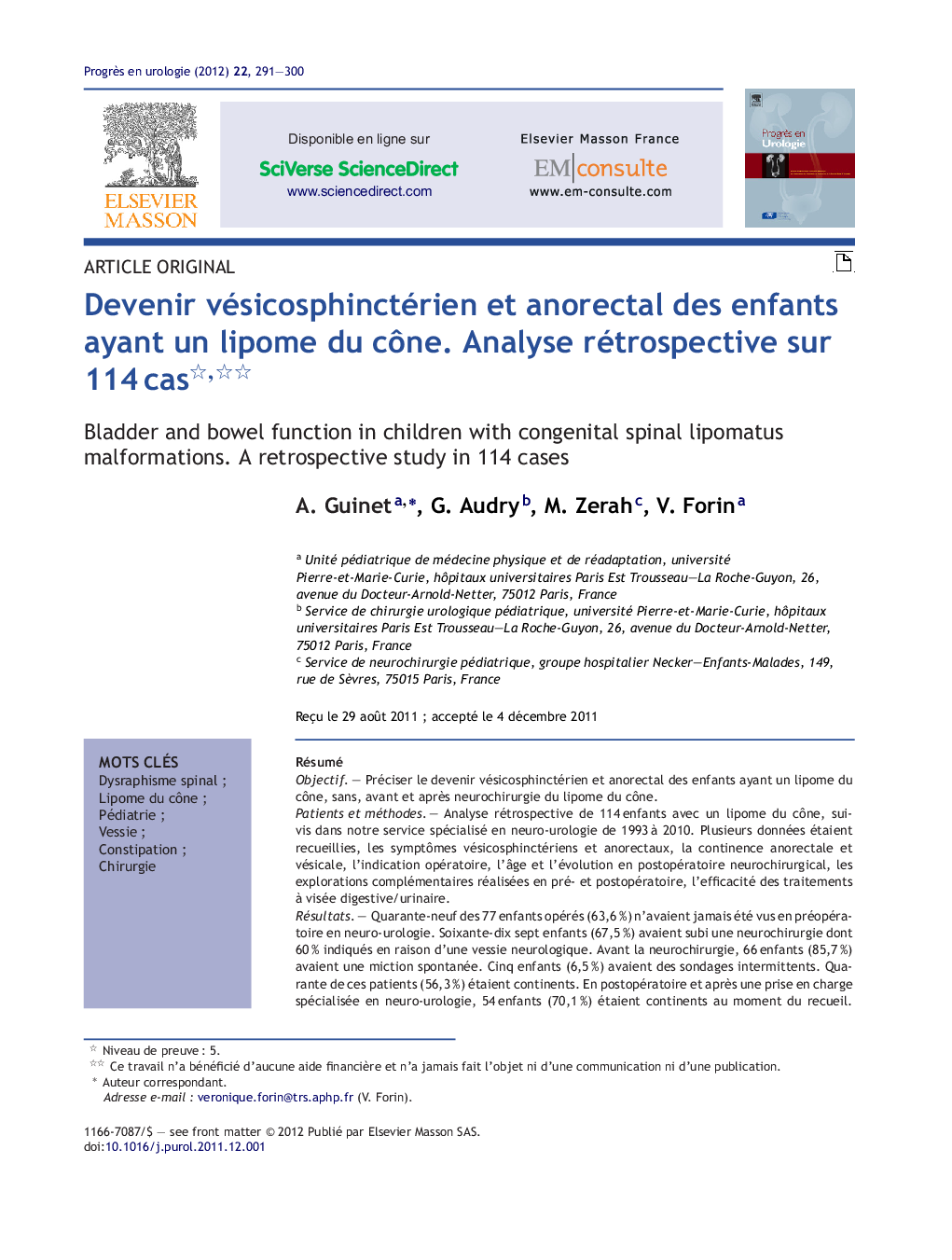| کد مقاله | کد نشریه | سال انتشار | مقاله انگلیسی | نسخه تمام متن |
|---|---|---|---|---|
| 3825127 | 1246801 | 2012 | 10 صفحه PDF | دانلود رایگان |

RésuméObjectifPréciser le devenir vésicosphinctérien et anorectal des enfants ayant un lipome du cône, sans, avant et après neurochirurgie du lipome du cône.Patients et méthodesAnalyse rétrospective de 114 enfants avec un lipome du cône, suivis dans notre service spécialisé en neuro-urologie de 1993 à 2010. Plusieurs données étaient recueillies, les symptômes vésicosphinctériens et anorectaux, la continence anorectale et vésicale, l’indication opératoire, l’âge et l’évolution en postopératoire neurochirurgical, les explorations complémentaires réalisées en pré- et postopératoire, l’efficacité des traitements à visée digestive/urinaire.RésultatsQuarante-neuf des 77 enfants opérés (63,6 %) n’avaient jamais été vus en préopératoire en neuro-urologie. Soixante-dix sept enfants (67,5 %) avaient subi une neurochirurgie dont 60 % indiqués en raison d’une vessie neurologique. Avant la neurochirurgie, 66 enfants (85,7 %) avaient une miction spontanée. Cinq enfants (6,5 %) avaient des sondages intermittents. Quarante de ces patients (56,3 %) étaient continents. En postopératoire et après une prise en charge spécialisée en neuro-urologie, 54 enfants (70,1 %) étaient continents au moment du recueil. Trente-sept enfants avaient des mictions spontanées (48 %). Trente-sept enfants (48 %) étaient aux sondages intermittents souvent associés à des traitements de l’hyperactivité détrusorienne. Cinquante-deux enfants (67,5 %) étaient constipés en postopératoire. Soixante-dix-sept pour cent des traitements mis en place en postopératoire étaient efficaces en termes de continence.ConclusionL’existence d’une vessie neurologique était une des principales indications de la neurochirurgie. Nos résultats mettent en évidence la nécessité d’un suivi neuro-urologique spécialisé afin de réaliser les explorations et les traitements adéquats urinaires et digestifs dans un but de préservation rénale et de continences.
SummaryObjectiveTo clarify bladder and bowel function of children with lipomas of the conus, without, before and after neurosurgery.Patients and methodsRetrospective analysis of 114 children with a lipomas of the conus, followed in our pediatric neuro-urology department from 1993 to 2010. Several data were collected: bladder and bowel symptoms, bladder and anorectal continence, neurosurgical indication and age, clinical modification after neurosurgery, investigations carried out in pre- and post-surgery treatment, associated bladder and bowel treatment.ResultsForty-nine of the 77 children (63.6%) operated on had never been seen before surgery in our neuro-urology department. Seventy-seven children (67.5%) underwent a neuro-surgery, 60% indicated due to a neurogenic bladder. Before neurosurgery, 66 children (85.7%) had spontaneous miction. Five children (6.5%) had bladder intermittent catheterization. Forty of these patients (56.3%) were continent. After neurosurgery and a specialized consultation in neuro-urology, 54 children (70.1%) were continent. Thirty-seven children (48%) had spontaneous miction. Thirty-seven children (48%) had bladder intermittent catheterization and drug of overactive detrusor. Fifty-two children (67.5%) were constipated after surgery. Seventy-seven percent of the treatments for bowel symptoms were effective in terms of continence.ConclusionThe existence of a neurogenic bladder was one of the main indications for neurosurgery. These results suggest that the complexity of care requires neurosurgical, urological surgeon and neuro-urology physician to achieve the explorations and urinary and digestive treatment in order to preserve renal function and both continences.
Journal: Progrès en Urologie - Volume 22, Issue 5, April 2012, Pages 291–300